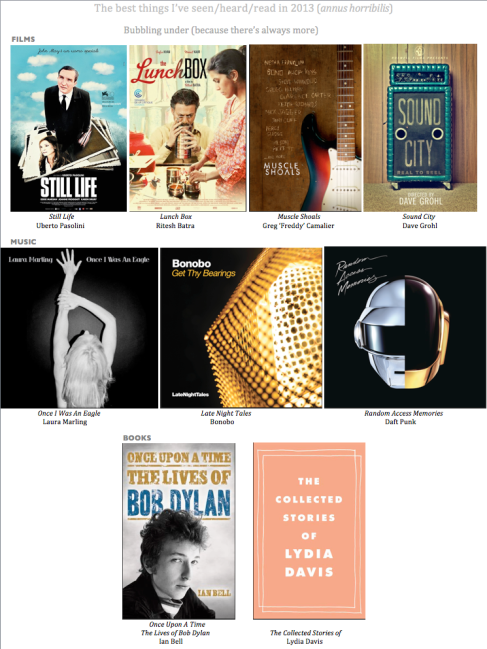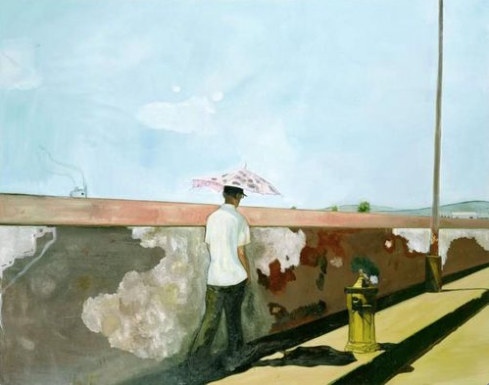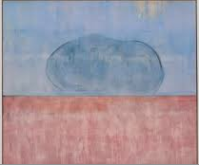“You will lose the ones you love… …Head is all heart has.”
Lydia Davis, Varieties of Disturbance
Despite the recent and ongoing crisis when most of us have been affected, and not only economically, and in a world that seems to generate more and more tat, it’s reassuring to realise just how much nourishment for the soul continues to be produced, discovered, re-discovered and made available to us in mostly digestible and affordable packages.
There may also be a huge crisis, mostly, I suspect, of confidence among the purveyors of culture, but there doesn’t appear to be much a crisis in the generation of it, in the broadest sense. On the contrary, as I put together my list the problem is always, and increasingly, what to leave out. Hence my ‘Bubbling under’ addendum:
Bubbling under films
Still Life is an affecting film that in some ways recalled the novel Stoner, in that it was about a man trying to work his way through life; a life that had not always gone as he might have hoped. A very English setting and story, it is directed by an Italian, Umberto Pasolini (no relation to the proletarian Pier Paolo but, funnily enough, a former investment banker and direct descendent of the aristocratic Luchino Visconti!).
One of the most engaging films of the year was The Lunch Box. Set in teeming Mumbai, it is the story of a widowed office worker and a woman who is trying to win her cold and distracted husband back by appealing to his stomach. Some women will try anything and fight. But it doesn’t work, also because, exceptionally, the food she prepares ends up on the desk of the widower. There ensues an exchange that keeps you hoping until the very end.
OK, now for the anorak stuff. Like so many of my friends, I grew up absorbing not only music but the minutiae of the whole rigmarole of recording; the names of producers, session musicians, engineers, backing singers and the studios where the records were made. Totally useless information, but, boys will be boys.
Two fascinating documentaries released this year pandered to the nerd in me; both about studios where great albums have been recorded: Muscle Shoals and Sound City.
Both these films tell quite different but remarkable stories about visionary producers, lost investments and extraordinary successes. And, of course, great music. But I realise its niche stuff.
Bubbling under music
Laura Marling is as English a rose as you’re likely to find. Maybe that’s why she decided she needed to get away. Having re-located to Los Angeles Once I Was An Eagle is the first product of her new lifestyle, and pretty damn good it is, too. All references to Joni Mitchell are, frankly, silly. Give the girl a break. Just listen to the album.
Late Night Tales is a series of ‘celebrity’ compilation albums that have been appearing over recent years and this is one of the best. I don’t actually know who Bonobo are, but the selection of music on this album, which can be listened to singly or as a combined single track, is brilliant.
I was only vaguely aware of Daft Punk, the cannily reclusive French duo, until this year when you couldn’t escape them. I also have a son who produces EDM (it stands for Electronic Dance Music, no, I didn’t either), and when he asked me if I’d ever heard of Giorgio Moroder I nearly fell off my chair. That encouraged me to listen to the album and, apart form anything else, you can’t not recognise and move to the guitar sound of Nile Rodgers. I’m not sure Daft Punk deserve to be quite as big as they are, there’s a fair amount of smart marketing going on, but Random Access Memories was unquestionably one of the albums of 2013.
Bubbling under books
It’s a weakness, I know, but Bob Dylan continues to fascinate and so I read yet another biography. But though Ian Bell’s attempt is highly readable and the bare bones of the story I already knew, there is a sense of the law of diminishing returns kicking in, the more we know, the less we understand! Only for the afflicted!
In a year in which the short story triumphed thanks to the award of the Nobel Prize for Literature to Alice Munro, I finally got round to reading another female, North American writer of short (sometimes very short) stories. Lydia Davis does not, perhaps have the range, or humanity, of Alice Munro, but these often dark tales of emotional struggle and personal ineptness are striking in their capacity to identify types and types of behaviour that, however odd and incomprehensible, we have all seen around us.







